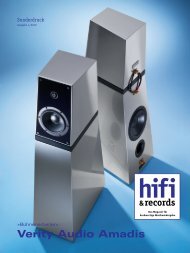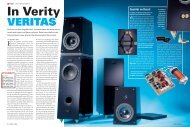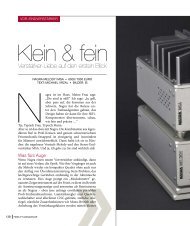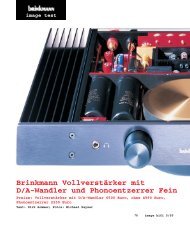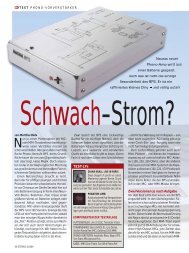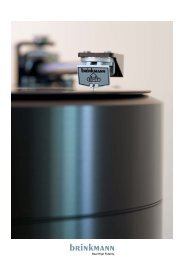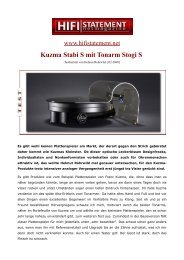You also want an ePaper? Increase the reach of your titles
YUMPU automatically turns print PDFs into web optimized ePapers that Google loves.
EQUIPMENT REVIEW<br />
A New Dawn…<br />
The <strong>Kuzma</strong> <strong>4POINT</strong> <strong>Tonearm</strong><br />
by Roy Gregory<br />
NIH; the acronym that stands for<br />
“Not Invented Here” might better be<br />
expressed as “Never Invented Here”<br />
when it comes to hi-fi. For every<br />
company that rejects out of hand any<br />
idea that they didn’t come up with,<br />
sheltering behind entrenched dogma,<br />
there must be at least a dozen that have<br />
never come up with anything original.<br />
They sit back, wait and see which way<br />
the wind’s blowing, keeping a weather<br />
eye open for any passing band wagon<br />
and ready to execute a philosophical Uturn<br />
with the alacrity of a London cabbie<br />
(and just about as much consideration<br />
for others).<br />
But real progress depends on the<br />
combination of all available information<br />
and thinking, with a few novel twists<br />
added for good measure. The resulting<br />
steps are often significant, either<br />
extending the notion of what is possible<br />
or bringing new levels of performance<br />
down to much lower prices. And<br />
because they so often build on existing<br />
thinking you can also often trace their<br />
“family trees”. So, one might think of<br />
the Zeta which spawned the <strong>Kuzma</strong><br />
Stogi, Mission Mechanic, SME 5 and<br />
ultimately the Rega RB300 (et al). Then<br />
there’s the line that stretches back from<br />
the Phantom, through the other Graham<br />
arms to the Michell Focus One. But the<br />
lineage that concerns us here starts with<br />
the Tri-Planar, evolves through the VPI<br />
JMW designs and emerges in the form of<br />
the <strong>Kuzma</strong> <strong>4POINT</strong>.<br />
It was the Tri-Planar that established<br />
the tandem benefits of an out-rigger (or<br />
offset) mounting for the main-bearing,<br />
coupled to a vernier type VTA tower that<br />
allows for record-by-record adjustment.<br />
It also established the practicality of<br />
mounting a longer, 10.5” tonearm within<br />
the compact dimensions of the decks<br />
then currently fashionable. The fact that<br />
a refined but otherwise virtually identical<br />
design is just as popular now, some 25years<br />
later, speaks volumes.<br />
No surprise then, that when<br />
Harry Weisfeld at VPI<br />
wanted to create his own<br />
tonearm, he<br />
adopted<br />
those<br />
groundbreaking<br />
ideas<br />
himself, adding<br />
interchangeable<br />
arm-tops sitting on a<br />
damped uni-pivot bearing<br />
into the mix, allowing users to<br />
change cartridges on a recordby-record<br />
basis too. For the first<br />
time, a cartridge and tonearm<br />
could be removed from a deck<br />
in a matter of moments, with all<br />
critical settings preserved intact.<br />
And while he was about it, Harry<br />
raised the stakes in the cable game<br />
too, offering a purpose built Nordost<br />
Valhalla internal wiring option.<br />
Which brings us to Franc <strong>Kuzma</strong>’s<br />
latest design, a tonearm that takes cues<br />
from his previous models and combines<br />
them all with the developmental path<br />
established by the Tri-Planar and VPI.<br />
And furthering the tradition, he has<br />
introduced a third bearing configuration,<br />
but one that’s unlike anything that’s gone<br />
before, in this or any other family tree!<br />
But before we get to that, let’s look at the<br />
major structural features of this new arm.<br />
Starting at the front end of the arm,<br />
we find the compact and heavily<br />
triangulated headshell first seen on<br />
the AirLine. However, even this has<br />
undergone a series of refinements:<br />
the shell itself is mounted on a stub<br />
extension with hexagonal<br />
profiles at each end<br />
and an allen grubscrew<br />
through its shaft. Slide the<br />
headshell into the end of<br />
the armtube and the hex<br />
sections achieve a positive<br />
mate, while a small hole<br />
in the top of the tube<br />
allows the grubscrew to<br />
be nipped up to lock<br />
the assembly firmly in<br />
place. Note that the<br />
arm cabling exits<br />
the tube behind<br />
the headshell<br />
junction; this is<br />
not a removable<br />
headshell in the<br />
true sense of<br />
the word and<br />
if you want to<br />
swap cartridges<br />
you will need<br />
to disconnect and<br />
reconnect their pins – but that beats the<br />
hell out of setting up from scratch. More<br />
importantly, the arrangement allows<br />
users to mount cartridges directly to<br />
the headshell, which eases the process<br />
considerably. There is also a threaded<br />
rod that can be screwed into the right<br />
hand shoulder of the shell, providing<br />
a finger lift or cueing aid.<br />
The arm tube itself employs<br />
<strong>Kuzma</strong>’s familiar two-piece tapered<br />
59
60<br />
EQUIPMENT REVIEW<br />
construction, allowing incredibly precise<br />
adjustment of azimuth, although in this<br />
case the effective length is actually 11”.<br />
This mates to a massive and incredibly<br />
deep bearing yoke, from the rear of<br />
which extend two threaded rods to carry<br />
the counterweights. The lower, thicker<br />
of these carries the composite balance<br />
weight, constructed from a single large<br />
“drum”, a set of five discs of different<br />
weights and interleaving hard plastic<br />
locators to help damp the assembly. This<br />
mix and match approach ensures that<br />
the main mass can sit as close to the pivot<br />
as possible. The thinner, top rod carries<br />
the long, narrow, locking downforce<br />
weight, familiar from the AirLine. The<br />
internal cabling exits<br />
from the<br />
inner side of<br />
the yoke, a short<br />
flexible section<br />
linking to a delrin<br />
cylinder that supports<br />
the arm-cable proper.<br />
Permanently attached to the<br />
arm tube, a small stub on the<br />
yoke allows the cable to be safely<br />
“parked”, the aluminium termination<br />
cylinder being clamped in place by a<br />
small grubscrew. Finally, a small<br />
but deep well on the side of the yoke<br />
allows fluid damping of the arm tube’s<br />
vertical motion.<br />
The integration of the arm tube and<br />
tonearm cable means that the cueing<br />
platform and VTA tower arrive as a<br />
separate assembly. This mounts using<br />
a simple post and collar arrangement<br />
which is compatible in terms of fixing<br />
and geometry, with the Linn three-bolt<br />
arrangement used by the Ittok, Ekos<br />
and others, albeit with a 40mm (not<br />
30mm) central hole. That means that<br />
in theory the <strong>4POINT</strong> can be mounted<br />
on any deck capable of supporting a<br />
Linn tonearm – providing it can also<br />
support the <strong>Kuzma</strong>’s not inconsiderable<br />
weight. And if no armboard exists, the<br />
manufacturer supplies both a mounting<br />
template and positioning jig, as well as<br />
a comprehensive toolkit and hardware<br />
for the arm. In fact, every aspect of<br />
this arm, from the superbly clear and<br />
comprehensive instructions through the<br />
fit and finish to the packaging elevates<br />
this product into the very highest<br />
echelon.<br />
Once the collar and post have been<br />
used to set the arm’s basic height, this<br />
can be preserved using a separate<br />
locking ring. Above the mounting post<br />
is positioned the VTA tower. First seen<br />
on the Airline and since adopted for<br />
the 313 and this design, this elegant<br />
arrangement employs a large,<br />
graduated knob to alter arm height<br />
and thus VTA in a continuous<br />
and repeatable manner,<br />
on a record by<br />
record basis<br />
if so desired. Once set, the VTA is<br />
locked by a cam linked to a cueingstyle<br />
lever behind the tower. It is a<br />
precise and beautifully damped set-up<br />
that’s easy and intuitive to use. My<br />
one complaint is that I’d like finer<br />
graduations on the knob, making<br />
repeatable adjustments easier, but<br />
apart from that this remains the bestexecuted<br />
VTA adjustment I’ve used.<br />
The VTA tower carries the outrigger<br />
arrangement that supports the cueing<br />
device, falling-weight bias and<br />
horizontal bearing (and associated<br />
damping trough).<br />
Which brings us to that bearing; the<br />
separate arm tube and bearing post<br />
might suggest a uni-pivot but this is a<br />
far more complex design than that.<br />
The bearing “post” is in fact an external<br />
sleeve that does sit on a vertical point (a<br />
la uni-pivot), but a second, horizontal<br />
point engages a polished trough on the<br />
front face of the post proper, preventing<br />
any fore and aft or sideways movement<br />
and thus stabilizing the sleeve. A<br />
horizontal plate is attached to the<br />
bottom of the bearing sleeve and it’s<br />
this that carries the attachment for the<br />
bias thread and also the outrigger that<br />
dips into the horizontal damping trough.<br />
But on the rear of that plate is a pair of<br />
bearing cups, angled slightly back from<br />
vertical (take a look at the pictures – in<br />
this case they truly are worth a thousand<br />
words). Drop the yoke on the arm tube<br />
over the bearing sleeve and two forward<br />
angled points sit in those cups, allowing<br />
free vertical movement (and justifying<br />
the <strong>4POINT</strong> moniker). The four pivots<br />
employed combined with the arm’s<br />
massive construction should provide a<br />
combination of negligible friction and<br />
excellent stability, while an outrigger<br />
added to the top of the bearing sleeve<br />
engages the trough on the side of the<br />
yoke to complete the independent<br />
horizontal and vertical damping<br />
layout. A small stub on the rear face<br />
of the outrigger supports the arm<br />
cable, the short flexible section<br />
allowing the arm unimpeded movement.<br />
Clearly, the separate arm tube<br />
construction means that entire tubes<br />
can be swapped, although not as easily<br />
or quickly as on the VPI arms. If you<br />
employ the vertical damping, that will<br />
need to be disengaged and then the<br />
armcable will need to be unshipped<br />
from the outrigger and “parked” back on<br />
the bearing yoke. The arm tube can then<br />
be lifted clear, although it’s still carrying<br />
the armcable and connected via that<br />
to the phono-stage. In part, that reflects<br />
that interchangability was never one of<br />
the design goals, although in practice,<br />
many of those looking to profit from
the opportunity on offer will have two<br />
separate phono inputs (one mono or<br />
configurable, one straight RIAA), which<br />
would ease things considerably.<br />
Finally (as if that wasn’t enough)<br />
there’s one more little wrinkle up<br />
the <strong>4POINT</strong>’s sleeve. You’ll notice a<br />
termination box, a foot or so down the<br />
arm cable. Look a lot closer and you’ll<br />
see that each cartridge tag is connected<br />
to a pair of wires coming from the arm<br />
tube. In fact, the arm is double wired,<br />
one set running from the tags in an<br />
uninterrupted run to the Silver Bullet<br />
plugs (an advantage over the breaks in<br />
the Lemo plug and phono sockets setup<br />
used by the VPI; the price paid for<br />
that arm’s peerless convenience). The<br />
other set connects to the phono sockets<br />
on the termination box. The cabling<br />
used is Crystal Cable throughout, but<br />
the provision of the termination box<br />
allows users to employ a different armcable<br />
from that point onwards<br />
should they so choose.<br />
The physical description<br />
should have underlined<br />
just how easy it is to set<br />
up the <strong>4POINT</strong>,<br />
especially<br />
as the Linn<br />
geometry and<br />
mounting has<br />
to be the most<br />
common pre-cut<br />
armboard. <strong>Kuzma</strong><br />
even provides an<br />
under-board fixing<br />
collar to provide even clamping to<br />
unthreaded armboards. But before<br />
you reach for your LP12 or Pink<br />
Triangle, make sure the <strong>Kuzma</strong>’s (off-set)<br />
mass isn’t going to upset the suspension,<br />
while the arm-cable is sufficiently stiff<br />
to impede free movement too. But<br />
assuming your ‘table is appropriate,<br />
then the stage by stage nature of the<br />
set-up, even down to the detachable<br />
headshell makes the process extremely<br />
straightforward, while the range of<br />
repeatable adjustments on offer means<br />
that there’s no excuse for anything other<br />
than optimum geometrical precision.<br />
Like its forebears, the Tri-Planar and the<br />
VPI (as well as earlier <strong>Kuzma</strong> designs)<br />
clever engineering ensures that you<br />
needn’t compromise any aspect of<br />
proper set-up on the altar of mechanical<br />
integrity<br />
This easily<br />
attainable<br />
geometrical<br />
precision is<br />
reflected in<br />
the quality and<br />
consistency of the sound,<br />
each cartridge used sounding<br />
more like itself than is usually<br />
the case. I ran both the Lyra<br />
Skala and Titan i, along with the<br />
vdH Condor, each with excellent results,<br />
although the differences between these<br />
three transducers, and especially the<br />
resolution gap between the two Lyras,<br />
has never more obvious. Ultimately,<br />
it was the Titan with which I did the<br />
majority of my listening, its transparency<br />
and dynamic resolution a perfect foil<br />
for the <strong>4POINT</strong>’s presence, life and<br />
energy. The arm was mounted on<br />
a fixed height Stabi XL4 tower,<br />
although I’m keen to try it with<br />
other decks too – especially<br />
the VPI TNT and <strong>Kuzma</strong>’s<br />
own Stabi Reference, a<br />
combination which I<br />
suspect could be the<br />
audio equivalent of<br />
Floyd Mayweather<br />
Jr – just without<br />
the mouth.<br />
EQUIPMENT REVIEW<br />
The first thing that strikes you about<br />
this arm is its sheer vivacity – quickly<br />
followed by its astonishing transparency,<br />
especially at low frequencies. I’ve never<br />
heard a pivoted arm that can image like<br />
this – and I’ve never heard any arm that<br />
does bass the way the <strong>4POINT</strong> does.<br />
The clarity and<br />
precision of<br />
deep notes, their<br />
timing, duration, the space<br />
between them and the air around<br />
them – but most of all the energy that<br />
propels them is in a class of its own. The<br />
normally grubby thuds of upright bass<br />
that underpin so many 60’s jazz tracks<br />
are taken in hand, given shape and<br />
pace, pitch and placement. They’re also<br />
given independence, never swamped<br />
by even the most frenetic big band tutti.<br />
So the wonderfully undulating bass<br />
line that underpins ‘Way Out Basie’<br />
(from Farmers Market Barbeque) takes<br />
on a sinuous vitality, an up-beat swing<br />
that breaths new life into the track’s<br />
underpinnings, leading naturally into the<br />
shockingly sudden brass stabs, tying the<br />
meandering solos into the fabric, keeping<br />
things constantly on the move – an ever<br />
present influence, shaping and guiding<br />
the music. Which is, of course, exactly<br />
how it should be – and so often isn’t. So<br />
many arms soften the bass notes and lose<br />
track of them altogether once the going<br />
gets tough that its something of a surprise<br />
to hear them rendered with the same<br />
audible clarity and easy independence<br />
that you experience live.<br />
That low frequency transparency<br />
contributes directly to the palpable<br />
acoustics conjured by the <strong>4POINT</strong>.<br />
That and the arm’s phenomenal<br />
stability; images simply don’t<br />
63
64<br />
EQUIPMENT REVIEW<br />
wander or shimmer the way they do<br />
with other arms – effects that we are so<br />
used to that you only notice them once<br />
they’re banished – a trick achieved by<br />
the Grand Prix Audio Monaco, another<br />
primo candidate to partner the <strong>Kuzma</strong>.<br />
This arm produces sound as solid as<br />
it looks, which given that<br />
it’s probably the<br />
most substantial yet<br />
handsome arm I’ve<br />
ever used, means<br />
pretty darned<br />
solid.<br />
That stability<br />
gives images and<br />
instruments a real presence<br />
that underpins the explosive<br />
dynamic potential of the<br />
<strong>4POINT</strong>. Brass rips the air<br />
and drum rolls cascade<br />
in a tumble of energy. But<br />
this energy is harnessed<br />
and concentrated, tied to<br />
the instruments producing<br />
it and the music it serves;<br />
nothing escapes, not one shred<br />
is overlooked or wasted. The<br />
result, when required, is a drive<br />
and momentum that is almost<br />
physically propulsive, a vitality that is<br />
exciting and bursting with a natural<br />
sense of life.<br />
But this isn’t just about big and bold,<br />
brash and ballsy. The <strong>Kuzma</strong> is all<br />
those things when it needs to be, but it<br />
is poised, delicate and controlled too.<br />
The really impressive thing is the way<br />
it exerts those qualities at the fff end of<br />
the scale as easily as it does at the other<br />
extreme – and the ease with which<br />
it allows thenm to coexist or transits<br />
between the two. The Ricci Carmen<br />
Fantasie on Decca is the perfect test in<br />
this regard, Bizet’s orchestral bombastics<br />
contrasting with the solo violin, the<br />
studied technique and precise measures<br />
of the Habanera a world away from the<br />
pell-mell flurries of the faster passages.<br />
The dramatic sweep and stark shadings<br />
delivered by the <strong>4POINT</strong> produce a vivid,<br />
torrid performance from the opening<br />
passages, one that leaves the listener<br />
almost breathless with the excitement<br />
and virtuosity<br />
it reveals.<br />
Yet the<br />
transition<br />
to the slow<br />
central passage<br />
is effortlessly<br />
natural, the<br />
delicate beauty and<br />
muted shadings cherished<br />
with a poise and dignity that<br />
seems almost beyond the<br />
scope of the same arm<br />
that generated those<br />
musical pyrotechnics<br />
that opened the piece.<br />
But just follow Ricci<br />
as he builds into<br />
the finale (and you<br />
will, because you<br />
won’t want to<br />
take the music<br />
off) and marvel<br />
at the way he<br />
bridges through<br />
the pizzicato<br />
sections to the<br />
lightening runs and<br />
phrases with which the piece concludes.<br />
This is a record I know intimately, one<br />
that I’ve played on literally dozens of<br />
decks and probably hundreds of systems.<br />
But it left me open-mouthed and grinning<br />
inanely at Ricci’s astonishing range,<br />
his ability to conjure and encompass<br />
such emotional contrasts and carry you<br />
from one to another so naturally that<br />
you don’t even notice his part in doing<br />
it. Of course, what I should have been<br />
impressed by was the fact that for the<br />
first time the <strong>4POINT</strong> had allowed the<br />
music to transcend mere technique, the<br />
unfettered dynamics, lucid phrasing,<br />
wide yet coherent bandwidth and<br />
absence of grain or edge finally allowing<br />
the performance to escape the grooves.<br />
In some ways this arm mirrors its<br />
lineage, combining the precise vitality<br />
and quickness of the Tri-Planar with<br />
the easy flow and rich harmonics of the<br />
VPI JMW, all built on the stability and<br />
presence of the Stogi Reference. But the<br />
<strong>4POINT</strong> is more, so much more than the<br />
sum of those parts. The Airline challenges<br />
it in terms of delineating depth and<br />
positional precision, and the pivoted arm<br />
can’t match the sheer fluidity, the grace<br />
through a phrase of the parallel tracker.<br />
But many a listener really won’t care,<br />
simply blown away by the life, energy,<br />
explosive dynamics, transparency<br />
and easy control of the <strong>4POINT</strong>; And<br />
that’s before they experience its<br />
absolute delicacy, micro dynamics<br />
and preservation of the smallest<br />
musical nuance. And if you are still<br />
not convinced, just try a vocal. The big<br />
<strong>Kuzma</strong> passes that most acid<br />
of tests with the same grace and charm<br />
it tackles everything else. Just don’t<br />
get spooked when you realize that<br />
Ella really IS in the room!<br />
TECHNICAL SPECIFICATIONS<br />
Type: Pivoted tonearm<br />
Bearing: <strong>Kuzma</strong> <strong>4POINT</strong><br />
Damping: Independent horizontal<br />
and vertical<br />
Mounting Geometry: Linn compatible<br />
Effective Length: 280mm<br />
Effective Mass: 13g<br />
Pivot To Spindle: 264mm<br />
Internal Wiring: Crystal Cable<br />
Weight: 1650g<br />
Price: £3950<br />
UK Distributor:<br />
Audiofreaks<br />
Tel. (44)(0)208 948 4153<br />
Net. www.audiofreaks.co.uk<br />
Manufacturer:<br />
<strong>Kuzma</strong> Ltd.<br />
Net. www.kuzma.si



